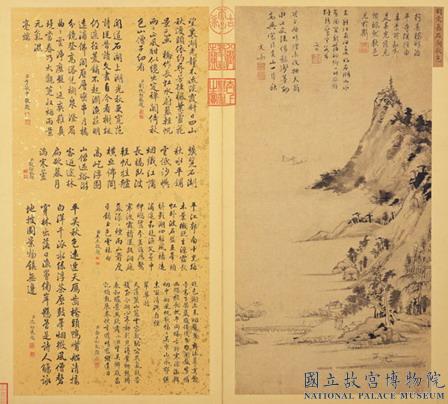名畫琳瑯 冊 明文嘉石湖秋色
推薦分享
資源連結
連結到原始資料 (您即將開啟新視窗離開本站)後設資料
- 資料識別:
- 故畫001292N000000010
- 資料類型:
- 類型:繪畫
- 型式:靜態圖像
- 著作者:
- 文嘉
- 主題與關鍵字:
- 秋景 江河、湖海 高士(士人、隱士) 漁夫、船夫 楊柳 房舍 寺廟 塔 橋 牌坊 帆船 耕織漁獵 百姓 鐘樓
- 出版者:
- 數位化執行單位:國立故宮博物院
- 格式:
- 本幅 65x32.8公分、對幅 65x32.8公分、全幅 71.5x78公分
- 關聯:
- 石渠寶笈續編(乾清宮),第一冊,頁504&*故宮書畫錄(卷六),第四冊,頁197&*文嘉(西元一五○一-一五八三年),字休承,號文水,文徵明的次子。傳承家學,能詩工書畫,山水筆墨疏秀,而以韻勝。 石湖在吳縣西南二十里,湖山掩映,風景勝絕,是吳郡文人杖履常經之所,吳派畫中以此為主題者甚多。本冊畫石湖秋景,雨後新霽,雲煙未收,樹石顯得蒼潤清麗。畫中之橋,名行春橋。山為楞伽山,山頂塔院名治平寺,又名楞伽寺。&*Wen Chia was the son of Wen Cheng-Ming. Following his father, he excelled at poetry, calligraphy, and painting. His landscape paintings are especially elegant and harmonious. Stone Lake is located 20 kilometers southwest of Soochow and is one of the area's scenic sites noted for beautiful hills and lakes. Wu School artists often made it the subject of their paintings. In this album, the autumn scenery of Stone Lake is shown after rain, just before the mist evaporates. Trees and rocks have a luxuriant beauty to them. Spring Bridge and Mt. Leng-chia are seen, while the pagoda and courtyard on the mountain belong to Chih-p'ing Temple (also known as the Leng-chia Temple).&*文嘉(西元一五○一-一五八三年),江蘇長洲人。徵明仲子,字休承,號文水。能詩工書畫,精山水,筆墨疏秀,而以韻勝。 畫石湖秋景,雨後新霽,雲煙未收。點畫樹葉先以淡墨,將乾之際,再施濃墨,濃淡交融,妙到毫巓。山石皴紋,稍稍見意而已,水墨漬染,亦饒變化。畫中之橋,名「行春橋」,山為「楞伽山」,山頂塔院,名「治平寺」,又名「楞伽寺」。此處為吳郡文人杖履常經之所,故吳派畫中以此為主題者甚多。 &*The Autumn Colors of Stone Lake Wen Chia (1501-1583) Ming Dynasty Wen Chia, Second son of the famous artist Wen Cheng-ming (1470-1559), was a native of Ch’ang-chou, Kiangsu. His style name was Hsiu-ching and his sobriquet, Wen-shui. An accomplished poet, calligrapher, and painter, he excelled at landscape painting, in which he is known for his exquisite, rhythmic brushwork. In this autumn scene of Stone Lake, the sky has just cleared after a storm, leaving some clouds still hanging in the sky. The leaves of the trees are particularly well done; dark ink was applied to a preliminary layer of light ink just as it began to dry, and thus the two layers blended together. The modeling lines and texture-strokes of the mountains and rocks are etched in only lightly, the washes of ink transforming the stone. The bridge in the painting is called “Traveling-in-Spring Bridge;” the mountain is called “Leng-chia Mountain;” and the pagoda and courtyard on the peak belong to the place known as both “Chih-p’ing Temple” and “Leng-chia Temple.” The area depicted here was frequently visited by the literati of the surrounding Wu Prefecture, and it often became the subject matter for artists of the Wu School of painting, which flourished in the fifteenth and sixteenth centuries. &*1.〈明文嘉石湖秋色〉,收入國立故宮博物院編輯委員會編,《山水畫墨法特展圖錄》(臺北:國立故宮博物院,1987年七月初版),頁67-68。
- 管理權:
- 國立故宮博物院
授權聯絡窗口
- 國立故宮博物院圖像授權、出版授權、影音資料授權-申請流程說明
http://www.npm.gov.tw/zh-TW/Article.aspx?sNo=03003061






